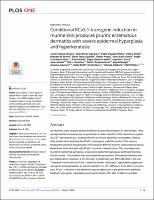Por favor, use este identificador para citar o enlazar este ítem:
https://repositorio.usj.es/handle/123456789/382
Registro completo de metadatos
| Campo DC | Valor | Lengua/Idioma |
|---|---|---|
| dc.contributor.author | Lozano-Gerona, Javier | - |
| dc.contributor.author | Olivan-Viguera, Aida | - |
| dc.contributor.author | Delgado-Wicke, Pablo | - |
| dc.contributor.author | Singh, Vikrant | - |
| dc.contributor.author | Brown, Brandon M. | - |
| dc.contributor.author | Tapia-Casellas, Elena | - |
| dc.contributor.author | Pueyo, Esther | - |
| dc.contributor.author | Valero Gracia, Marta Sofía | - |
| dc.contributor.author | García-Otín, Ángel Luis | - |
| dc.contributor.author | Giraldo, Pilar | - |
| dc.contributor.author | Abarca-Lachén, Edgar | - |
| dc.contributor.author | Surra, Joaquín Carlos E. | - |
| dc.contributor.author | Osada, Jesús | - |
| dc.contributor.author | Hamilton, Kirk L | - |
| dc.contributor.author | Raychaudhuri, Siba Prasad | - |
| dc.contributor.author | Marigil, Miguel Angel | - |
| dc.contributor.author | Juarranz, Ángeles | - |
| dc.contributor.author | Wulff, Heike | - |
| dc.contributor.author | Miura, Hiroto | - |
| dc.contributor.author | Gilaberte, Yolanda | - |
| dc.contributor.author | Köhler, Ralf | - |
| dc.date.accessioned | 2020-04-29T09:18:09Z | - |
| dc.date.available | 2020-04-29T09:18:09Z | - |
| dc.date.issued | 2020-03-09 | - |
| dc.identifier.citation | Lozano-Gerona J, Oliván-Viguera A, Delgado-Wicke P, Singh V, Brown BM, Tapia-Casellas E, et al. (2020) Conditional KCa3.1-transgene induction in murine skin produces pruritic eczematous dermatitis with severe epidermal hyperplasia and hyperkeratosis. PLoS ONE 15(3): e0222619. https://doi.org/10.1371/journal.pone.0222619 | es_ES |
| dc.identifier.issn | 1932-6203 | es_ES |
| dc.identifier.uri | https://repositorio.usj.es/handle/123456789/382 | - |
| dc.description | Ion channels have recently attracted attention as potential mediators of skin disease. Here, we explored the consequences of genetically encoded induction of the cell volume-regulating Ca2+-activated KCa3.1 channel (Kcnn4) for murine epidermal homeostasis. Doxycycline-treated mice harboring the KCa3.1+-transgene under the control of the reverse tetracycline-sensitive transactivator (rtTA) showed 800-fold channel overexpression above basal levels in the skin and solid KCa3.1-currents in keratinocytes. This overexpression resulted in epidermal spongiosis, progressive epidermal hyperplasia and hyperkeratosis, itch and ulcers. The condition was accompanied by production of the pro-proliferative and pro-inflammatory cytokines, IL-β1 (60-fold), IL-6 (33-fold), and TNFα (26-fold) in the skin. Treatment of mice with the KCa3.1-selective blocker, Senicapoc, significantly suppressed spongiosis and hyperplasia, as well as induction of IL-β1 (-88%) and IL-6 (-90%). In conclusion, KCa3.1-induction in the epidermis caused expression of pro-proliferative cytokines leading to spongiosis, hyperplasia and hyperkeratosis. This skin condition resembles pathological features of eczematous dermatitis and identifies KCa3.1 as a regulator of epidermal homeostasis and spongiosis, and as a potential therapeutic target. | es_ES |
| dc.format.extent | 18 p. | es_ES |
| dc.format.mimetype | application/pdf | es_ES |
| dc.language.iso | eng | es_ES |
| dc.publisher | Public Library of Science | es_ES |
| dc.relation | This work was supported by the Government of Aragón (DGA-METIC–consortium; B04_17R), FP7-PEOPLE-MC-CIG to RK, FIS-CB06/07/1036 to PG and RK, ERC-2014-StG-638284, DPI2016-75458-R, T39_17R to EP; FIS-PI16/02112 to ALGO; NHLBI-R01-HL080173, NCRR-P20-RR018751 to HM. JLG received a DGA-PhD scholarship (C072/2014). BMB was supported by the NCATS (UL1 TR001860 and linked award TL1 TR001861). KLH received sabbatical support from the University of Otago. The funders had no role in study design, data collection and analysis, decision to publish, or preparation of the manuscript. | es_ES |
| dc.rights | Atribución 4.0 Internacional | * |
| dc.rights.uri | http://creativecommons.org/licenses/by/4.0/ | * |
| dc.subject | Dermatitis | es_ES |
| dc.subject | KCa3.1 | es_ES |
| dc.title | Conditional KCa3.1-transgene induction in murine skin produces pruritic eczematous dermatitis with severe epidermal hyperplasia and hyperkeratosis | es_ES |
| dc.type | info:eu-repo/semantics/article | es_ES |
| dc.subject.unesco | Enfermedad de la piel | es_ES |
| dc.identifier.doi | https://doi.org/10.1371/journal.pone.0222619 | es_ES |
| dc.rights.accessrights | info:eu-repo/semantics/openAccess | es_ES |
| Aparece en las colecciones: | Artículos de revistas | |
Ficheros en este ítem:
| Fichero | Descripción | Tamaño | Formato | |
|---|---|---|---|---|
| Conditional KCa3.1-transgene induction in murine skin produces pruritic eczematous dermatitis with severe epidermal hyperplasia and hyperkeratosis.pdf | 3,33 MB | Adobe PDF |  Visualizar/Abrir |
Este ítem está sujeto a una licencia Creative Commons Licencia Creative Commons

